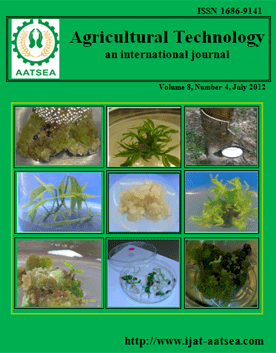ThaiScience
ThaiScience
INTERNATIONAL JOURNAL OF AGRICULTURAL TECHNOLOGY
Volume 17, No. 01, Month JANUARY, Year 2021, Pages 169 - 184
Comparative energy bill of inbred and hybrid rice genotypes grown under conventional and organic production system in bay, laguna, philippines
May Soe Oo, Mendoza, T. C., Paelmo, R. F. and Organo, N. D.
Abstract Download PDF
The major energy hotspots for the conventional production system were agrochemical inputs particularly nitrogen fertilizer at12336 MJ ha-1 (62%) and pesticides (1592 MJ ha-1, 8%). The major energy hotspot in organic system was applied organic fertilizer at 1440 MJ ha-1 (25%), and labor at 1134 MJ ha-1 (20%) due to the labor intensiveness of preparing and applying the organic fertilizer. Transplanting one seedling per hill reduced the amount of seed energy used per hectare up to 91% (80kg seeds were used in the conventional while only 4kg/ha at 1 seedling per hill and 30cm x 30cm spacing under organic). The use of synthetic fertilizer in conventional, especially nitrogen, and chemical pesticides led to greater total energy bill. In turn, energy return over energy input (EROEI) was only 4 under conventional and 15 for organic methods . The energy productivity (EP) under organic was higher at 0.88 kg grain MJ-1, while it was only 0.26 kg grain MJ-1 under conventional method. Organic system had 3.4 times higher EP than conventional due to the lower TEI (5715 MJ ha-1) in organic and higher TEI (19821 MJ ha-1) in conventional method. Likewise, the net energy in organic (77634 MJ/ha) was higher by 12% (68403 MJ/ha) than in conventional systems making organic more energy efficient. Organic system not only reduced the energy bill by 71% of total energy input but also gave comparable grain yield to the conventional system. It required 1.164 MJ to produce 1.0 kg unmilled rice under organic, while it was 3.83 MJ kg-1 under conventional or 3.3 times more energy than organic method.
Keywords
Energy input, Energy output, Energy productivity, Net energy gain, Energy hotspotsINTERNATIONAL JOURNAL OF AGRICULTURAL TECHNOLOGY
Published by : Association of Agricultural Technology in Southeast Asia (AATSEA)
Contributions welcome at : http://www.ijat-aatsea.com
